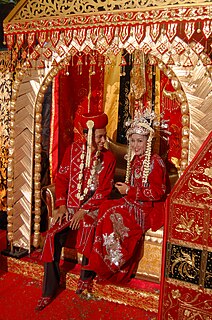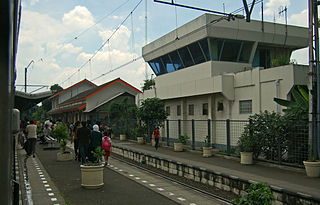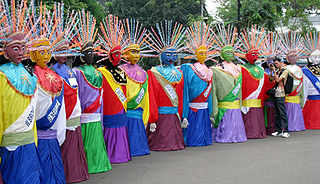| Setu Babakan | |
|---|---|
| Type | Urban park |
| Location | Jagakarsa, Jakarta |
| Coordinates | 6°20′30″S106°49′26″E / 6.341667°S 106.823889°E Coordinates: 6°20′30″S106°49′26″E / 6.341667°S 106.823889°E |
| Area | 289 acres |
| Owned by | Pemprov DKI Jakarta |
| Operated by | Department of Parks and Cemetery, Jakarta |
| Status | Open all year |
Setu Babakan or Babakan lake (Setu or Situ means Small Lake) is located at Srengseng Sawah, Jagakarsa, Jakarta in Indonesia. The lake is about 5 kilometers southeast of Ragunan Zoo at the center of the Betawi Cultural Village, a site considered as part of the cultural heritage of Jakarta, which is devoted to the preservation of the indigenous Betawi culture. [1] The location of the Betawi Cultural Village is replacement of the previous Condet (Betawi) Cultural Village which is eroded by the time.
Jagakarsa is a subdistrict of South Jakarta, one of the administrative cities in Jakarta Indonesia. Jagakarsa is the southernmost subdistrict of South Jakarta Jagakarsa Subdistrict is bounded by Ciliwung River to the east, Krukut River to the west, Margasatwa-Sagu-Joe-T.B.Simatupang-Poltangan Road to the north, Boundary marks with Depok to the south.

Jakarta, officially the Special Capital Region of Jakarta, is the capital and largest city of Indonesia. Located on the northwest coast of the world's most populous island Java, it is the centre of economics, culture and politics of Indonesia, with a population of 10,075,310 as of 2014. Jakarta metropolitan area has an area of 6,392 square kilometers, which is known as Jabodetabek. It is the world's second largest urban agglomeration with a population of 30,214,303 as of 2010. Jakarta is predicted to reach 35.6 million people by 2030 to become the world's biggest megacity. Jakarta's business opportunities, as well as its potential to offer a higher standard of living, attract migrants from across the Indonesian archipelago, combining many communities and cultures.

Indonesia, officially the Republic of Indonesia, is a country in Southeast Asia, between the Indian and Pacific oceans. It is the world's largest island country, with more than seventeen thousand islands, and at 1,904,569 square kilometres, the 14th largest by land area and the 7th largest in combined sea and land area. With over 261 million people, it is the world's 4th most populous country as well as the most populous Muslim-majority country. Java, the world's most populous island, contains more than half of the country's population.
Setu Babakan has an area of about 289 acres, which covers two natural lakes namely, Setu Babakan and Setu Mangga Bolong. Situ Babakan Lake has an area of 32 hectares (79 ac) in which the water flows in from the Ciliwung River and currently is used for fish farming by the Betawi people who live in the vicinity of the lake. [2]
There are more than 100 floating net cages placed in the lake to breed different kinds of fish, including carp, tilapia, and several species of ornamental fish. The lake is a place for aquatic recreational activities, such as rafting, and fishing. The garden surrounding the lake is cultivated with fruit and other plants, such as banana, coconut, and guava.

Carp are various species of oily freshwater fish from the family Cyprinidae, a very large group of fish native to Europe and Asia.

Tilapia is the common name for nearly a hundred species of cichlid fish from the tilapiine cichlid tribe. Tilapia are mainly freshwater fish inhabiting shallow streams, ponds, rivers, and lakes, and less commonly found living in brackish water. Historically, they have been of major importance in artisanal fishing in Africa, and they are of increasing importance in aquaculture and aquaponics. Tilapia can become a problematic invasive species in new warm-water habitats such as Australia, whether deliberately or accidentally introduced, but generally not in temperate climates due to their inability to survive in cold water.

Rafting and white water rafting are recreational outdoor activities which use an inflatable raft to navigate a river or other body of water. This is often done on whitewater or different degrees of rough water. Dealing with risk and the need for teamwork is often a part of the experience. This activity as a leisure sport has become popular since the 1950s, if not earlier, evolving from individuals paddling 10 feet (3.0 m) to 14 feet (4.3 m) rafts with double-bladed paddles or oars to multi-person rafts propelled by single-bladed paddles and steered by a person at the stern, or by the use of oars. Rafting on certain sections of rivers is considered an extreme sport, and can be fatal, while other sections are not so extreme or difficult. Rafting is also a competitive sport practiced around the world which culminates in a world rafting championship event between the participating nations. The International Rafting Federation, often referred to as the IRF, is the worldwide body which oversees all aspects of the sport. Whitewater rafting can be traced back to 1811 when the first recorded attempt to navigate the Snake River in Wyoming was planned. With no training, experience, or proper equipment, the river was found to be too difficult and dangerous. Hence, it was given the nickname “Mad River.” the first commercial rafting trip took place. On June 9, 1940, Clyde Smith lead a successful trip through the Snake River Canyon.















